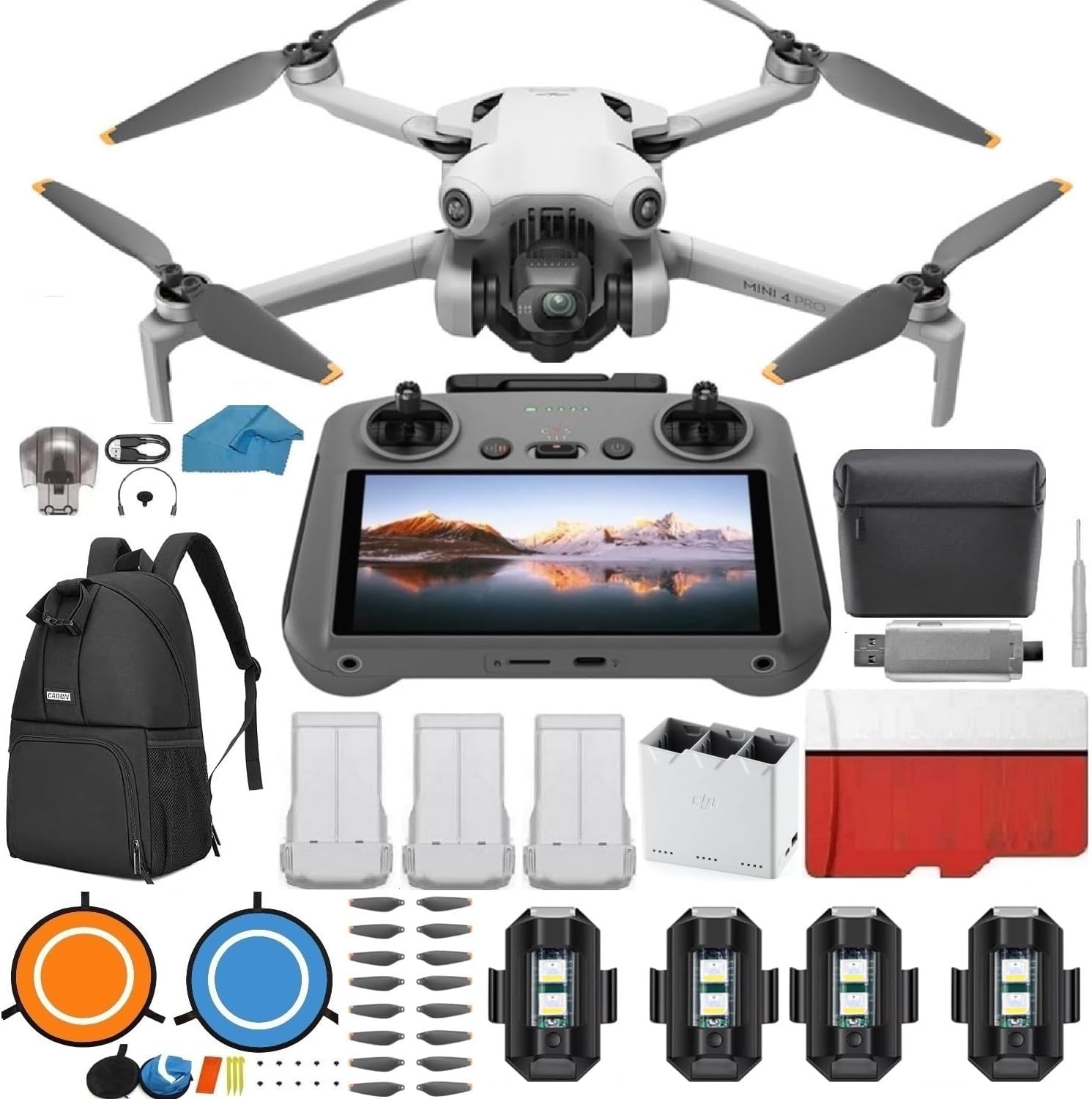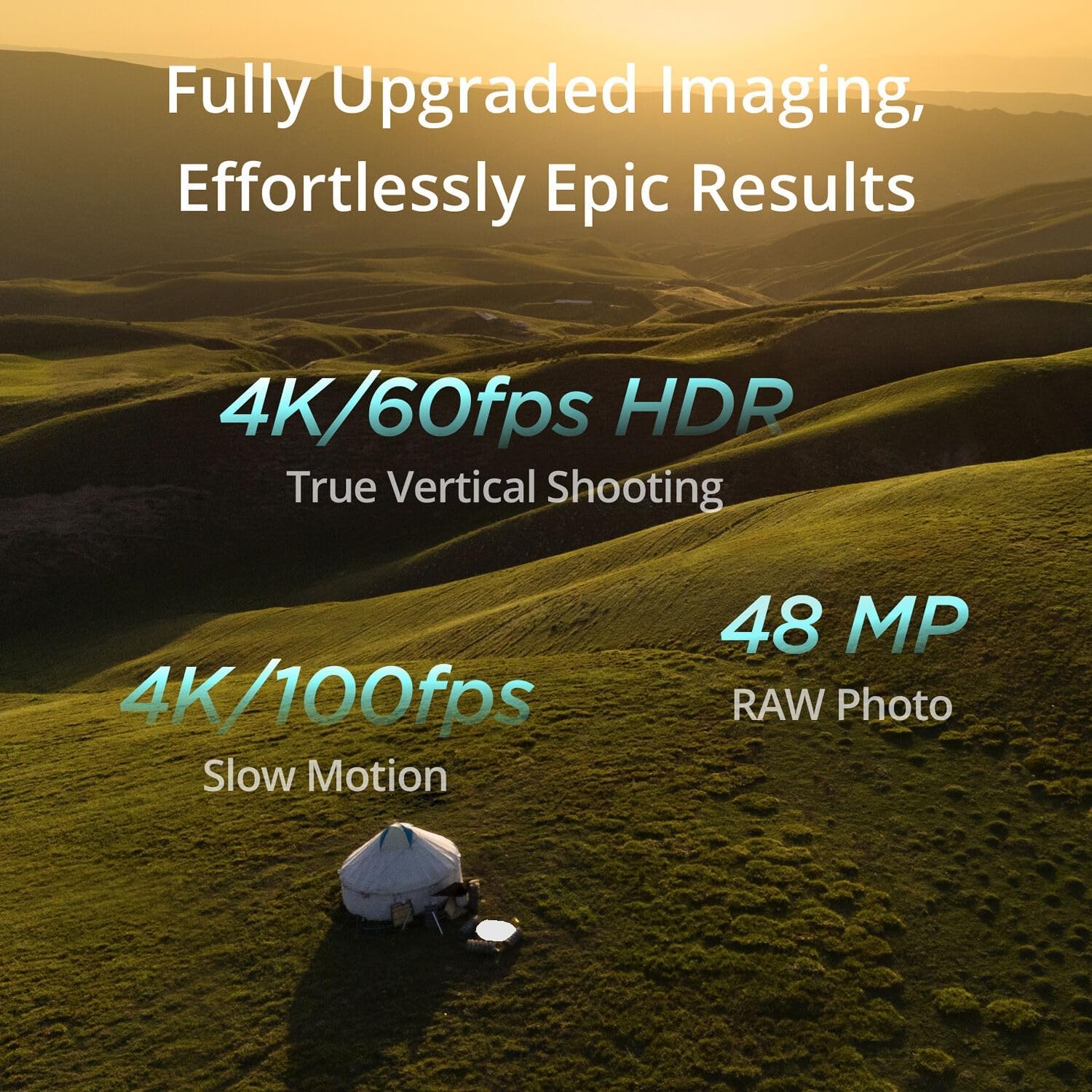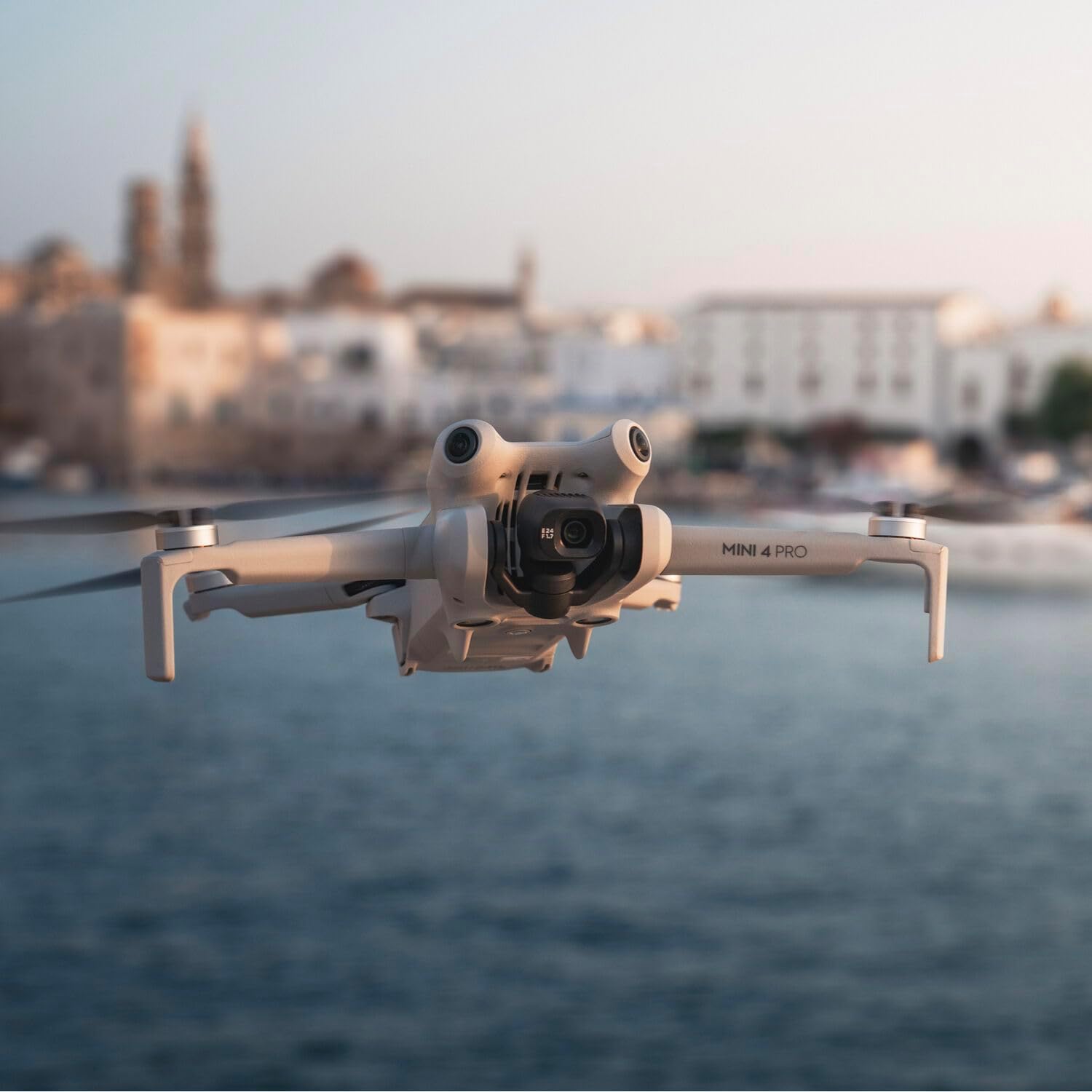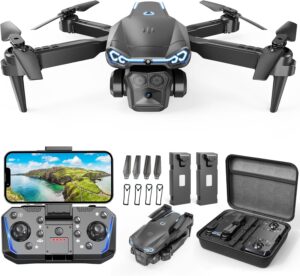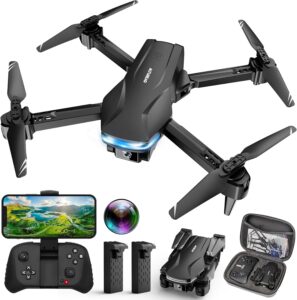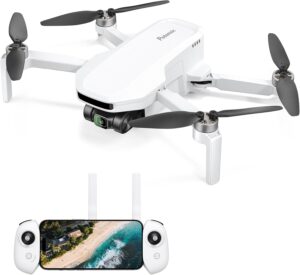Have we ever wished a drone could be our travel buddy and our camera crew in one, without making us feel like we need a pilot’s license to have any fun?
The Bundle That Tries to Think of Everything
We’ll admit it: we are suspicious of bundles. They can feel like mystery boxes that come with one treasure and seventeen cable ties we’ll never use. This one, however, is unusually thoughtful. It packages the DJI Mini 4 Pro with the DJI RC 2 remote (the one with the built-in screen), plus extras that actually smooth out the whole flying-to-footage process.
Here’s what the bundle includes, and yes, we used every last thing at least once:
- DJI Mini 4 Pro drone (under 249 grams)
- DJI RC 2 remote controller with built-in monitor
- 3 intelligent flight batteries
- Two-way charging hub
- Shoulder bag
- Battery charger with AC cable
- Spare propellers (10 pieces)
- Gimbal holder
- Cables and adapters
- Quick start manuals
- 128GB microSD card
- USB 3.0 SD card reader
- Microfiber cleaning cloth
- Case
- Landing pad
- Screwdriver and 6 spare screws
- 4 strobe lights
We didn’t have to run out for a memory card, a reader, or something soft to wipe the lens. The landing pad saved us from the daily exfoliation of our propellers on gravel, and the strobe lights made spotting orientation in dusky conditions a lot less nerve-wracking.
DJI Mini 4 Pro Folding Drone with RC 2 Remote (With Screen) Fly More Combo, 4K HDR Video Camera for Adults, Under 249g, Omnidirectional Sensing, 3 Batteries Bundle with 128 gb SD Card Strobe Lights and More
What Matters Most at a Glance
Sometimes we just want the plain-English version of why a thing is special. We put our favorite features in a single table, so we can remember what we paid for when we forget why this tiny aircraft feels so grown-up.
| Feature | What It Is | Why It Matters |
|---|---|---|
| Under 249 g takeoff weight | Ultralight drone class | In many regions, recreational flyers of sub-250 g drones face simpler requirements. It’s easier to carry, easier to justify. |
| 4K/60 HDR video | High-res, high-frame-rate recording with HDR | Sunrises and neon-lit city blocks look crisp and dimensional without a ton of post work. |
| Vertical shooting | Native vertical (portrait) capture | No cropping, no gymnastics. We can post mobile-friendly footage straight from the camera. |
| Omnidirectional obstacle sensing | 360-degree sensing with automatic avoidance | Confidence booster for beginners and a stress reducer for all of us. |
| DJI RC 2 remote with screen | Built-in monitor, no phone required | Faster setup and fewer interruptions from social notifications mid-flight. |
| O4 video transmission | Strong, stable signal to the controller | Clear, responsive live view that calms the “where is it?” voice in our head. |
| Three batteries + charging hub | Extended flying and rapid turnaround | We can stay in the air for a long stretch, then recharge smartly between outings. |
| Included 128GB microSD + reader | Storage and transfer tools in the box | No extra errands; we shoot, we pull footage, we’re editing after lunch. |
| Strobe lights | Clip-on visibility lights | Better visual orientation. Useful in dim conditions; check local rules for night flight. |
| Landing pad and case | Takeoff aid and protection | Keeps debris out of the gimbal and makes us look more prepared than we feel. |
We’ll go deeper on each of these, but the pattern is clear: this is a travel-friendly, safety-forward camera drone that prioritizes ease of use and quick sharing.
First Impressions: It Feels Like a Real Camera, Not a Toy
We have a soft spot for things that look cute and then surprise us with competence. The Mini 4 Pro folds down the way we wish most furniture folded: decisively and without tantrums. Unfolded, it has that semi-serious stance—tiny legs, big eyes—that makes birds curious and joggers cautious.
Weight and Build
At under 249 grams, the Mini 4 Pro sits in a sweet spot. It’s the difference between “toss it in the daypack with a sweater” and “does this deserve its own suitcase?” The plastic doesn’t feel brittle or cheap; it feels like what happens when engineers are told “be smart about the grams” and actually listened.
In many regions, recreational flying with sub-250 g drones comes with simplified registration or operational thresholds. It’s part convenience, part mental permission slip. Still, we always check local regulations—location and intent (recreational vs. commercial) change the rules.
The Folding Mechanism
Once we learned the order of operations—back arms first, then front—the fold/unfold routine took one coffee sip. No jabbing our knuckles into the joints. The gimbal protector clicks on with a very pleasing “this is protected now” sound. We love that sound.
The RC 2 Remote with Built-In Screen
We didn’t realize how much time we lose fussing with phones until we stopped. The DJI RC 2 has a bright screen that means we turn it on, turn the drone on, and go. No texts or low-battery phone meltdowns interrupting us mid-shot. Outdoors, the display is readable. Is it as retina-searing as pro-grade monitors? No. But it’s a sane balance of brightness and battery life, and we prefer not having to peel our phone out of a case each time.
Setting Up: Familiar, Faster, and Less Fiddly
The first flight with any new aircraft is part magic, part checklist. We appreciate that this bundle acts like a patient friend who has already laid out everything on the dining table.
App, Firmware, and Pairing
- Power on the RC 2, then the drone.
- Follow the on-screen prompts to connect and update firmware.
- Calibrate the compass and gimbal when prompted, especially if we’ve traveled a long distance since the last flight.
- Format the included 128GB microSD card in-camera to avoid file system surprises.
We were airborne within half an hour the very first time, including updates. After that, it’s much faster—closer to the time it takes to lock our front door.
The Landing Pad and Why We Use It
We once tried lifting off from a soccer field, which sounds idyllic until we watched the gimbal throw a tiny tantrum over grass tips. The landing pad helps the sensors see clean ground, keeps dust from swirling into the gimbal, and makes our launch zone obvious so curious folks know where not to step. Consider it a polite “stage” for your miniature lead actor.
Strobe Lights and Visibility
The included strobe lights clip onto the arms and dramatically improve visibility. We can spot orientation better at a distance, especially at dusk. That said, lights don’t make every flight legal. We stick to local rules about night operations and visual line of sight. The strobes are a helpful tool, not a magic permission slip.
Flight Performance: Calm, Predictable, and More Capable Than It Looks
We expect small drones to be skittish. This one, even in gusty air, holds its position like it practiced. It steadies itself before we start worrying about a wobble.
Stability and Control
Controls are responsive without being twitchy. Switching to Cine mode for slow, precise moves helps us look like we know what we’re doing, even when we’re framing through branches or hovering near water. Normal mode is everyday-smooth. Sport mode is a thrill when the wind picks up or we just need to move.
Wind Resistance
It punches above its weight, but we respect physics. On a breezy coastal day, it held position with small, controlled micro-adjustments. We keep a side-eye on the on-screen wind warnings; they’re not nagging, they’re just the drone asking not to be sailed like a paper boat.
Range and Signal
DJI’s O4 transmission system is a quiet hero. The live view stays crisp and fluid. We can fly within line of sight without the picture breaking into squares or the controller screaming about signal loss. Maximum range varies by region and regulation, but practically, we’re far more often limited by our eyeballs than by the radio link.
Camera: 4K/60 HDR, Vertical Magic, and Night Scenes That Don’t Lie
The camera is the reason we bring the drone, and this one makes an argument for itself on the first flight. It handles extremes—golden light and dim corners—so gracefully that we stopped bracketing everything “just in case.”
4K/60 HDR That Actually Helps
HDR done badly is a mess of glowing whites and muddy blacks. The Mini 4 Pro’s implementation is the opposite. Sky detail holds, shadows stay believable, and we don’t need to flatten it later to make it watchable. We can stick with 4K/60 for motion-friendly footage and still keep that dynamic range. There’s also higher frame-rate slow motion available if we want to turn spray into diamonds or make waves look like satin.
Vertical Shooting, No Cropping Required
Native vertical capture is a quiet revolution if we share on social. We press record in portrait orientation and our footage is immediately ready for stories, reels, and every relative who watches video exclusively on a phone. No editing contortions. No sacrificing resolution to crop later.
Low-Light and Night Scenes
We’re not cinematographers living in a moody neon movie, but at dusk the Mini 4 Pro makes us look like we might be. Night scenes retain color without drowning in noise. It’s a small-sensor camera, so we still avoid pitch-black landscapes, but lit streets and twilight skies come through beautifully. If we keep the movement smooth and avoid sudden pans, the footage looks expensive.
Color Profiles and Editing
We shoot standard and flat/log profiles depending on the plan. For quick social posts, standard is our friend. When we want more room to grade, log profiles give us pliable files with extra highlight and shadow detail. We get consistent skin tones and skies that don’t clip into oblivion. Editing is straightforward—nothing feels fussy or oversharpened straight out of camera.
Stills That Surprise Us
We didn’t buy this as a stills camera, but the photos hold their own. High-resolution options capture crisp detail for landscapes, and if the light is interesting, the results are wall-worthy. We’ve printed a few. We felt very grown up about it.
Safety: Omnidirectional Sensing That Feels Like a Co‑Pilot
We are perfectly capable of flying into a tree. The drone’s omnidirectional sensing politely declines our worst ideas. It sees obstacles in all directions and either stops or finds a path around them depending on our settings.
Confidence for Beginners, Comfort for Everyone
The sensors significantly reduce the chance of “that sickening crunch.” We still fly as if the drone doesn’t have any help because that’s good habit, but it’s hard to overstate how much calmer we feel when threading between branches or backing away from a subject.
Return to Home That Actually Returns to Home
We test RTH every time we fly somewhere new. The Mini 4 Pro does it with the determined focus of a dog let off leash: up to a safe height, back along a sensible path, and down with a surprisingly gentle touchdown—especially if we give it that landing pad bullseye. We set our RTH altitude high enough to clear local surprises like power lines.
The Remote: Why the Built-In Screen Wins Our Mornings
There’s a particular chaos that comes from juggling a phone, a controller, and a coffee. The RC 2 with a screen removes one of those variables, and suddenly our mornings are less like a slapstick routine.
Bright Enough, Simple Enough
The RC 2’s screen is bright enough for midday park flying and very readable at golden hour. We like the tactile switches and the two dials for gimbal and exposure. We also like not having to disable 47 phone notifications to see a histogram.
No Phone, Fewer Problems
With the RC 2, we don’t worry about the right cable or whether the app is still signed in. We tap, we fly. The controller battery lasts long enough to outlast our attention span, and it recharges along with the drone batteries in a satisfying little charging ecosystem.
Battery Life: Real-World Minutes, Not Fantasy
Manufacturers love to quote best-case numbers measured on windless Tuesdays with no panic maneuvers. In our world, we plan for real life.
What We Actually Get
- Quoted flight times for the Mini 4 Pro with the standard batteries hover around the mid-30-minute mark.
- In our mixed conditions—some wind, some hovering, some spirited flying—we end up landing around 25–28 minutes to avoid pushing our luck.
- Multiply that by three batteries, and we’re looking at well over an hour of active flying per outing.
Landing with a buffer is a habit we’ve learned to love. Nothing ruins a day like seeing “Low Battery RTH” while we’re lining up our best shot.
The Two-Way Charging Hub
This little plastic brain does more than charge. It prioritizes batteries in the order that gets us back in the air fastest. We can also use it to top up the controller or our phone via USB. It’s the charging version of a friend who always remembers the power strip.
Accessories That Are Actually Useful
This bundle is refreshingly practical. It doesn’t shower us with trinkets; it anticipates the things that cause tiny crises and solves them.
The Case and Shoulder Bag
The case protects the drone from the indignities of backpacks. The shoulder bag keeps the whole kit tidy and grab-and-go ready. We far prefer carrying one bag than rummaging through three different pockets wondering where the propeller screws went.
Spare Propellers, Screwdriver, and Screws
We pretend we won’t clip a twig. And then we do. Having spare props and the right screwdriver means that instead of sulking, we do a five-minute pit stop. The spares come labeled, which is one of those “someone thought this through” details.
Microfiber Cloth
This is a small thing, but we use it constantly. The lens stays clean; flare stays cinematic instead of smeary.
Landing Pad and Strobes
Between the landing pad and strobe lights, we fly with more confidence in more places. The pad keeps debris at bay; the strobes help us keep orientation. We still abide by local laws and line-of-sight requirements.
Handling and Modes: From Careful to Confident
The three standard flight profiles—Cine, Normal, Sport—change not just speed but personality. We switch to Cine for careful reveals and control around obstacles, Normal for most of life, and Sport to beat a gust or bring the drone back quickly. The gimbal stabilization makes even fast passes look like they’re shot from a much heavier rig.
Intelligent modes like tracking and automated paths help when we’re filming ourselves or when we want a complex move without learning how to juggle six inputs at once. We set careful subject-boxes and check our surroundings before we let the drone “do it for us,” but when used thoughtfully, these features deliver swoopy shots with a lot less stress.
Storage and Workflow: Shoot, Transfer, Edit, Post
We love not having to think about storage while we’re learning a new machine. The included 128GB microSD card is generous. We formatted it in-camera and never hit a wall mid-flight.
File Transfer That Doesn’t Make Us Cry
The included USB 3.0 card reader makes a measurable difference. We pop the card out, plug into the laptop, and files zip across. We’ve also used the app for quick transfers in the field, but for a bigger editing session, the reader is our preferred path. Some onboard storage is present for “we forgot the card” emergencies, but we treat it as a safety net, not the plan.
Editing Reality
We’ve cut footage in everything from mobile apps to full-suite editors. The Mini 4 Pro’s files are friendly to both. Color grading on the flatter profile behaves, and the default color is pleasant for same-day posts. Stabilization is handled in-camera, so we’re not applying heavy post filters just to make it watchable.
Who It’s For (And Who It Isn’t)
We like to imagine the drone that pleases everyone, but we’ve met humans. Preferences are personal. Here’s where this one lands.
Travelers and Hikers
The sub-250 g weight is the gift that keeps on not making our shoulders ache. The bundle’s compact bag means we can throw it in with a jacket and go. Vertical video helps us make quick trip posts without the “I’ll edit when I get back” lie.
Content Creators and Small Teams
4K/60 HDR and reliable tracking mean we can produce professional-feeling pieces without a crew. The RC 2 streamlines setup time, so we catch moments instead of announcing “just five more minutes” to everyone.
Beginners
Omnidirectional obstacle sensing plus a landing pad equals fewer heart attacks. It’s beginner-friendly without capping our growth. We can start in gentle modes and grow into more advanced moves as we go.
Who Might Want Something Else
- If we need optical zoom or dual-camera flexibility, a higher-tier, heavier model may be the better fit.
- If we want a blindingly bright monitor for harsh midday sun, the pro-tier controller is brighter (and pricier).
- If we want 45-minute flights per battery, we’d look at larger-capacity batteries where allowed, understanding the weight and regulatory trade-offs.
Range, Rules, and Reality Checks
We never treat “maximum range” like a dare. Transmission tech has improved, but line-of-sight rules exist for good reasons. In practice, the O4 link feels solid well past where our comfort ends. When trees and buildings whisper “maybe don’t,” we don’t.
We also keep in mind:
- Sub-250 g often means simpler requirements for recreational flying, but commercial use and some regions have different rules.
- Night operations and strobe-light requirements vary. We use our strobes to see and be seen, but they’re not a universal pass.
- Firmware updates sometimes add features and sometimes change behavior; we skim the notes like they’re a plot twist.
Little Quirks We Noticed (And Didn’t Mind)
No gadget is perfect. These didn’t spoil our mood; they just made us nod sagely.
- In bright noon sun, the RC 2’s screen is readable, but we sometimes shade it with a hat brim for critical focus.
- Wind is physics, and a tiny drone is a kite with a PhD. We plan for gusts and leave margin.
- The landing pad occasionally attracts curious dogs. We try not to give them haircuts with the props.
Tips We Wish Someone Had Told Us on Day One
We love looking wise in hindsight. Here are the bits that moved from “maybe” to “always” for us.
- Set your Return-to-Home altitude higher than the tallest nearby surprise: trees, power lines, heroic sculptures.
- Format the microSD card in-camera after backing up footage, especially before trips.
- Keep props clean; dust and grit make tiny planes behave like tiny gremlins.
- Practice vertical filming and framing before your “real” shoot. It’s oddly satisfying and saves time later.
- Stop flying before the last drop. Land with a buffer and your battery will thank you.
- Pay attention to the wind arrow and speed readouts. A tailwind out is a headwind home.
Real-World Use Cases That Won Us Over
We brought the Mini 4 Pro into enough situations to trust it, and here’s what stuck.
- Sunrise harbor: We lifted off as fishing boats puttered out. 4K/60 HDR kept the sky from blowing out and the water from collapsing into mush. We posted a vertical clip while our coffee cooled.
- City roofline at golden hour: We traced building edges, gliding slow and low. Omnidirectional sensing kept us honest, and the footage didn’t shimmer or stair-step.
- Forest trail at dusk: We used the landing pad because forest floors are all tiny swords, and the strobe lights to keep orientation as the trail darkened. The footage was moody and clean.
- Family picnic: We turned on ActiveTrack, drew a box around our slow-moving relatives, and got a gentle overhead arc as if we had choreography and walkie-talkies.
Comparing to the Alternatives (Without Starting a Family Feud)
If we’re choosing among DJI’s compact models, our brain holds this quick map.
- Mini 3 Pro vs. Mini 4 Pro: The Mini 4 Pro’s omnidirectional sensing is the headline difference for safety and confidence, plus improvements in transmission and intelligent modes. If we prize obstacle coverage, the 4 is the safer bet.
- Air-series models: Heavier, more wind-stable, often with additional camera options. We trade compact convenience and sub-250 g benefits for performance and features. There’s no wrong answer—only our shoulder’s opinion.
Reliability and Maintenance: A Small Routine Goes a Long Way
We treat the drone like a camera with wings. It rewards that mindset.
- Check and swap props if they get nicked. They’re cheap; crashes are not.
- Keep the gimbal locked during transport. That little protector is the unsung hero of your bag.
- Update firmware at home with good Wi‑Fi whenever possible, not on a windy cliff edge.
- Wipe the lens with the microfiber cloth, not our shirt. We can’t believe we have to remind ourselves of this.
Sound, Neighbors, and Being a Good Citizen
The Mini 4 Pro is quieter than older models, but it’s still a flying instrument. We don’t hover near people, even if we feel stealthy. We wave at the curious, answer basic questions, and don’t be that person who thinks a park is a private set. If someone says “Is that allowed?” we take it as our cue to be gracious and informed, not defensive.
The Learning Curve: Fun Faster Than Expected
We felt competent after the first battery, confident after the second, and a little smug by the third. The combination of a responsive controller, friendly safety net, and a camera that flatters our choices makes learning genuinely enjoyable. Mistakes are less punishing. Wins come early. That matters more than specs on a chart.
Value: Why This Combo Makes Sense
The “Fly More” package with three batteries and a charging hub is the only way we’d buy this. Two batteries are fine until we have a real plan; three batteries mean the day can unfold without us guarding every minute in the air. The included 128GB card, reader, landing pad, and strobes turn this from “buy a thing” into “start flying now.” We didn’t expect to appreciate the micro things as much as we did, but together they save time, space, and a few choice words.
Our Favorite Moments, Captured Cleanly
The best compliment we can give a drone is that it disappears when we’re using it. The Mini 4 Pro with the RC 2 does that. It doesn’t nag, it doesn’t glitch, and it makes the footage we saw in our heads show up on the screen. We planned less and created more, which is the whole point.
Limitations Worth Noting (We’re Not Mad, Just Honest)
- Small sensors can’t rewrite physics at midnight. Give it some light and it’ll reward you.
- The RC 2 screen is good, not stadium-tier. If we need surgical brightness, there are pricier options.
- Strong winds are still strong winds. The Mini 4 Pro holds its own, but we still pick our days.
Safety and Regulations: Our Friendly Reality Check
- Sub-250 g is a helpful category, but rules vary by country and by whether we’re flying for fun or work. We check our local aviation authority’s guidance before flights.
- We keep the drone within visual line of sight. Line-of-sight is a safety principle, not a suggestion.
- Strobe lights improve visibility, but they aren’t a universal stamp for night operations. Some regions have specific brightness and visibility requirements.
We like flying more than arguing, so we err on the side of being considerate and compliant.
What We’d Tell a Friend Who’s on the Fence
If we were texting a friend who’s hovering over the buy button, we’d say:
- If safety nets comfort you, omnidirectional sensing is worth it.
- If you want to skip phone wrangling, the RC 2 screen is bliss.
- If you care about vertical video and HDR, this camera is your happy place.
- If you want a simple, complete kit that works right away, this bundle’s extras aren’t fluff—they’re the difference between “someday” and “Saturday.”
A Note on Care While Traveling
We toss it in the bag and go, but with a few habits:
- Props folded inward, gimbal protector on.
- Batteries at safe charge levels if packed for flights (we store them in our carry-on).
- Firmware updated before the trip, not during.
- Spot-check local rules at our destination; some scenic places have strict regulations.
Audio Notes: How Loud Is It, Really?
It’s more of a hum than a buzz, and less like a swarm than older models. Still audible, but lower-pitched and less alarming to wildlife and toddlers. We fly higher or farther out when people are around so it becomes background instead of headline.
The Intangible: Confidence and Playfulness
The Mini 4 Pro rewards curiosity. We try a shot, see how forgiving the sensing is, and then try another. We don’t have that pit-of-stomach feeling that one twitch means the end. The camera’s HDR renders à la “oh, that’s what it felt like to stand there,” which is a rare thing. It’s the difference between a clip and a memory.
Final Thoughts: A Small Drone That Makes Big Memories
We came for portability and stayed for the competence. The DJI Mini 4 Pro Folding Drone with RC 2 Remote Fly More Combo is a travel-friendly machine that doesn’t make us compromise on image quality or safety. The 4K/60 HDR footage looks beautiful without fuss, the vertical shooting is a quiet revolution for sharing, and the omnidirectional obstacle sensing lets us breathe while we’re learning—or while we’re getting fancy.
The bundle’s extras are not fluff. Three batteries, a smart charging hub, an included 128GB card and reader, a landing pad, strobes, spares, and a decent case turn a purchase into a practice. There’s nothing we had to run out and buy before doing real work. We set it up, we flew, we came home with footage we loved.
No drone does everything, but this one does the important things gracefully. It travels light, flies steady, sees danger before we do, and records the kind of video that makes us look back and think, “We were there.” And, maybe more important, “We got the shot.”
Disclosure: As an Amazon Associate, I earn from qualifying purchases.
